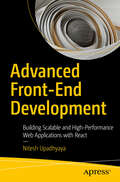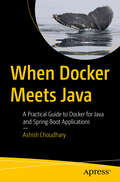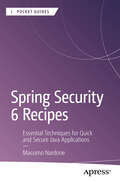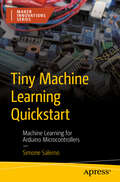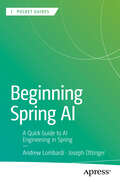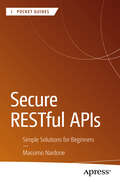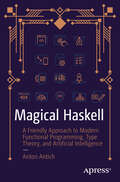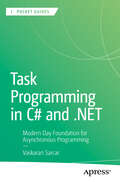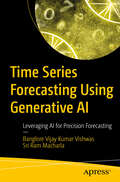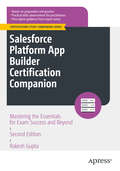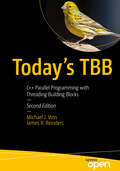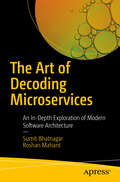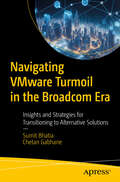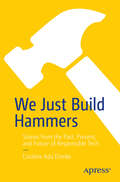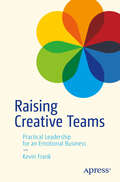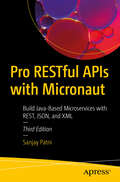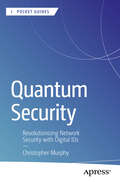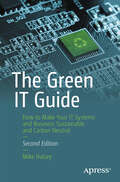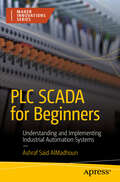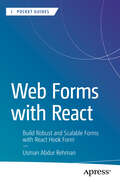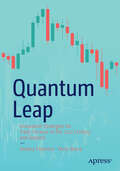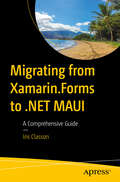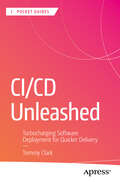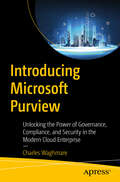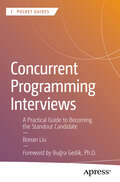- Table View
- List View
Advanced Front-End Development: Building Scalable and High-Performance Web Applications with React
by Nitesh UpadhyayaThis book is your comprehensive guide to mastering React, the most popular library for building modern web applications. Designed for developers at all levels, it offers a structured approach to understanding and applying React&’s core and advanced concepts to create responsive, scalable, and high-performance web applications. Starting with the basics, such as components, JSX, and state management, the book gradually progresses to advanced topics like context API, hooks, routing, and performance optimization. Every chapter is enriched with hands-on examples and step-by-step guides to help you solidify your understanding of React&’s ecosystem. The book encourages you to dive deeper into essential best practices, including code maintainability, testing strategies, and leveraging third-party libraries for UI components. It also explores modern state management tools, techniques for optimizing performance, and adopting cutting-edge deployment strategies with platforms like Netlify and Vercel, ensuring that the applications you build are robust and reliable. Beyond just React&’s core concepts, this book emphasizes practical application through a real-world project: building a fully functional e-commerce application. From implementing dynamic product listings to creating a seamless checkout flow with payment gateway integration, you&’ll gain hands-on experience that prepares you for real-world challenges. By the end of this book, you&’ll not only master React but also develop the skills to build, test, and deploy high-quality web applications that meet the demands of today&’s fast-paced development landscape. Whether you&’re a beginner or a seasoned developer, this book will elevate your expertise and help you stay ahead in the evolving world of web development. What You'll Learn: The foundational concepts of React, including JSX, components, and state management. How to use advanced React techniques, such as hooks, context API, performance optimization, and routing. How to create responsive, scalable, and maintainable web applications using modern React libraries and tools. Understand practical approaches to building a real-world e-commerce application, including dynamic product listings, cart functionality, and payment gateway integration Gain expertise in techniques for optimizing performance, testing, and deploying React applications to platforms like Netlify. Who is this book for: Software architects and developers with intermediate knowledge of HTML, CSS, and JavaScript, frontend developers, and full-stack developers
When Docker Meets Java: A Practical Guide to Docker for Java and Spring Boot Applications
by Ashish ChoudharyDiscover how to become a more efficient Java developer using Docker. This book will help you streamline your development process, boost portability, and enhance the efficiency of your applications. Docker has transformed the landscape of application and deployment by simplifying the creation and management of development environments, saving valuable time and reducing compatibility issues. With this book, you will learn how to package Java applications into Docker containers, making them consistent and portable across different environments. As a result, you’ll gain the expertise to efficiently scale and manage your applications, ensuring they run smoothly in production to boost development efficiency. This book sets itself apart through its emphasis on Java developers’ specific needs and challenges, providing relevant examples and use cases. The hands-on practical approach provides you with the necessary skills to be a more valuable Java developer. What You Will Learn Understand the fundamental concepts of Docker and containerization Package Java applications into Docker containers Gain hands-on experience in Dockerizing Java applications Efficiently test, debug, deploy, and scale Java applications using Docker Acquire skills that will make you a more valuable and efficient Java developer Who This Book Is For Java developers who want to make their applications more portable and easier to manage
Spring Security 6 Recipes: Essential Techniques for Quick and Secure Java Applications (Apress Pocket Guides)
by Massimo NardoneEnsure robust web security for your Java applications in just a few days. This recipe-driven, practical pocketbook provides a straightforward guide to quickly developing and deploying secure enterprise applications using the Spring 6 Framework, Spring Boot 3, and the H2 database. The book is organized into problems and corresponding recipes, offering solutions for both small and large challenges. First, you will learn how to install all essential development tools, such as IntelliJ IDEA, JDK v17, and Maven. Then you will dive into recipes on using Spring Security 6 with JSP tags and Thymeleaf and integrating security features through Spring Boot 3 Initializr. Finally, you'll be equipped to build your own Spring Boot project using Spring Security, Spring Data JDBC, and the H2 database. This recipes guide is ideal for readers who want to get up and running with only the essential security features in a fraction of time. Its simplified approach offers immediate results for securing Java applications. What You Will Learn Set up and configure Spring Security 6 installation tools Explore the basics of integrating Spring Security 6 with JSP tags, Thymeleaf, and Spring Boot 3 Initializr Build and deploy a secure Spring Boot application using Spring Data JDBC and the H2 database Who This Book Is For Beginners in Spring Security 6, Boot 3 Initializr, and H2 DB, and assumes you have some basic web development and security experience. It is suitable for busy readers who are seeking a simple, focused approach for immediate results. For more comprehensive coverage, detailed explanations, and advanced topics, we recommend Pro Spring Security: Securing Spring Framework 6 and Boot 3-based Java Applications.
Tiny Machine Learning Quickstart: Machine Learning for Arduino Microcontrollers (Maker Innovations Series)
by Simone SalernoBe a part of the Tiny Machine Learning (TinyML) revolution in the ever-growing world of IoT. This book examines the concepts, workflows, and tools needed to make your projects smarter, all within the Arduino platform. You’ll start by exploring Machine learning in the context of embedded, resource-constrained devices as opposed to your powerful, gigabyte-RAM computer. You’ll review the unique challenges it poses, but also the limitless possibilities it opens. Next, you’ll work through nine projects that encompass different data types (tabular, time series, audio and images) and tasks (classification and regression). Each project comes with tips and tricks to collect, load, plot and analyse each type of data. Throughout the book, you’ll apply three different approaches to TinyML: traditional algorithms (Decision Tree, Logistic Regression, SVM), Edge Impulse (a no-code online tools), and TensorFlow for Microcontrollers. Each has its strengths and weaknesses, and you will learn how to choose the most appropriate for your use case. TinyML Quickstart will provide a solid reference for all your future projects with minimal cost and effort. What You Will Learn Navigate embedded ML challenges Integrate Python with Arduino for seamless data processing Implement ML algorithms Harness the power of Tensorflow for artificial neural networks Leverage no-code tools like Edge Impulse Execute real-world projects Who This Book Is For Electronics hobbyists and developers with a basic understanding of Tensorflow, ML in Python, and Arduino-based programming looking to apply that knowledge with microcontrollers. Previous experience with C++ is helpful but not required.
Beginning Spring AI: A Quick Guide to AI Engineering in Spring (Apress Pocket Guides)
by Andrew Lombardi Joseph OttingerDiscover how to use Large Language Models in the Spring Framework. This quick guide equips developers with insights into the strengths and limitations of Spring AI and how to leverage the model for typical use cases. First, you will orient yourself to the new and exciting landscape of AI and Spring integration. You will learn how to issue simple queries, asking the right questions to get the results you want. From there, you will be empowered to select the right model for functionality and refinement, building a simple yet effective chat bot using real-world examples. Additionally, the book explores how to generate images, refine them, and how to send source images when appropriate. Lastly, the book focuses on how Spring AI and LLMs affect the developer landscape, including pitfalls and ethical concerns. Designed for fast adoption, this book provides targeted guidance on integrating AI and LLMs into your projects within days. Through a pragmatic approach, it emphasizes direct utilization of the API. What You Will Learn Explore popular use cases for LLMs Gain insight into the Spring AI module, including its capabilities and limitations Know how to create effective queries and interactions for AI-driven conversations and image generation Discover strategies for selecting an appropriate LLM service and model Acquire skills to AI-proof your job and understand why it is NOT a replacement What This Book Is Spring developers who are new to AI and focused on the essentials without exhaustive framework details. This is an optional supplement to the more comprehensive Apress book, Beginning Spring 6.
Secure RESTful APIs: Simple Solutions for Beginners (Apress Pocket Guides)
by Massimo NardoneSecure your RESTful APIs with confidence and efficiency. This straightforward guide outlines the essential strategies and best practices for protecting sensitive data when developing RESTful APIs for your applications. Inside, you’ll explore the fundamental functionalities to implement industry-standard authentication authorization mechanisms for Java applications. With chapters covering key security concerns, data protection, and designing and testing secure APIs, this book provides a hands-on approach to protecting user data, validating inputs, and implementing security mechanisms such as JSON Web Tokens (JWT) and OAuth2 authentication. This book offers a focused introduction without unnecessary complexity. Whether you are a beginner or busy professional, this is the only book designed to help you secure your RESTful APIs in no time. What You Will Learn Understand the fundamentals of RESTful APIs and why it is critical to secure them Identify common security risks concerning RESTful APIs and explore effective protection techniques Know how to design and test RESTful APIs, including with input and response data validation Review examples of how to secure JSON Web Token (JWT) and OAuth3 with RestFUL APIs Who This Book is For Web developer beginners who want to learn how to develop Security RESTful APIs applications
Magical Haskell: A Friendly Approach to Modern Functional Programming, Type Theory, and Artificial Intelligence
by Anton AntichDiscover a unique and fun approach to adopting modern typed functions programming patterns. This book uses playful metaphors and examples to help you learn Haskell through imagination, building on math without relying on imperative crutches or technical complexity. You’ll use math to build completely different Typed Functional patterns from the ground up and understand the link between building Mathematics through Types and constructing Haskell as a programming language. Intended for working with various applications, especially AI-powered apps, the book gently builds up to what are normally considered complex and difficult concepts all without needing a PhD to understand them. Illustrative explanations will guide you to tackle monads, using monad transformer stacks to structure real programs, foldable and traversable structures, as well as other Type classes. This book will also help you structure programs efficiently and apply your own abstractions to real-life problem domains. Next, you’ll explore exciting advancements in AI, including building with OpenAI APIs, creating a terminal chatbot, adding web functionality, and enhancing with retrieval-augmented generation. Finally, you’ll delve into AI multi-agents and future directions using Arrows abstraction, reinforcing Haskell’s design. Magical Haskell is a solution for programmers who feel limited by imperative programming languages but are also put off by excessively mathematical approaches. What You Will Learn Grasp a solid math foundation without complex technicalities for Types and Typeclasses. Solve problems via a typed functional approach and understand why it’s superior to what’s available in the imperative language world (“if it compiles, it runs”). Build your own abstractions to efficiently resolve problems in any given domain. Develop AI frameworks in Haskell, including chatbots, web functionality, and retrieval-augmented generation. Who This Book Is For Haskell programmers of all levels and those interested in Type Theory.
Task Programming in C# and .NET: Modern Day Foundation for Asynchronous Programming (Apress Pocket Guides)
by Vaskaran SarcarAt a high level, to understand asynchronous programming, you need to be familiar with task programming, efficient use of the async and await keywords, and a few more important topics. However, task programming is the first major step towards modern-day asynchronous programming. This book tries to simplify the topic with simple examples, Q&A sessions, and exercises The book starts with an introduction to asynchronous programming and covers task creation and execution. Next, you will learn how to work with continuing and nested tasks. Next, it demonstrates exception handling with different scenarios. Towards the end, you will understand how to manage task cancellations through examples and case studies. After reading this book, you can write efficient codes for multithreaded, asynchronous, and parallel development in C#. What You Will Learn: Dig deep into task programming which is an essential part of the concurrent and multithreaded developments. Learn modern-day C# features that are foundations of asynchronous programming How the advanced features in C# such as delegates, lambdas, generics, etc. can be used in concurrency Who This Book is For: C# and .NET developers
Time Series Forecasting Using Generative AI: Leveraging AI for Precision Forecasting
by Banglore Vijay Vishwas Sri Ram Macharla"Time Series Forecasting Using Generative AI introduces readers to Generative Artificial Intelligence (Gen AI) in time series analysis, offering an essential exploration of cutting-edge forecasting methodologies." The book covers a wide range of topics, starting with an overview of Generative AI, where readers gain insights into the history and fundamentals of Gen AI with a brief introduction to large language models. The subsequent chapter explains practical applications, guiding readers through the implementation of diverse neural network architectures for time series analysis such as Multi-Layer Perceptrons (MLP), WaveNet, Temporal Convolutional Network (TCN), Bidirectional Temporal Convolutional Network (BiTCN), Recurrent Neural Networks (RNN), Long Short-Term Memory (LSTM), Deep AutoRegressive(DeepAR), and Neural Basis Expansion Analysis(NBEATS) using modern tools. Building on this foundation, the book introduces the power of Transformer architecture, exploring its variants such as Vanilla Transformers, Inverted Transformer (iTransformer), DLinear, NLinear, and Patch Time Series Transformer (PatchTST). Finally, The book delves into foundation models such as Time-LLM, Chronos, TimeGPT, Moirai, and TimesFM enabling readers to implement sophisticated forecasting models tailored to their specific needs. This book empowers readers with the knowledge and skills needed to leverage Gen AI for accurate and efficient time series forecasting. By providing a detailed exploration of advanced forecasting models and methodologies, this book enables practitioners to make informed decisions and drive business growth through data-driven insights. ● Understand the core history and applications of Gen AI and its potential to revolutionize time series forecasting. ● Learn to implement different neural network architectures such as MLP, WaveNet, TCN, BiTCN, RNN, LSTM, DeepAR, and NBEATS for time series forecasting. ● Discover the potential of Transformer architecture and its variants, such as Vanilla Transformers, iTransformer, DLinear, NLinear, and PatchTST, for time series forecasting. <span sty
Salesforce Platform App Builder Certification Companion: Mastering the Essentials for Exam Success and Beyond (Certification Study Companion Series)
by Rakesh GuptaSalesforce Platform App Builder Certification, second edition is a comprehensive guide for budding and intermediate developers aiming to deepen their understanding of Salesforce. This book will start with the basics of Salesforce, shedding light on the limitations of its declarative platform and guiding readers on when to choose programmatic development or explore App Exchange solutions. The journey through the book will then delve into various configurations like data management and analytics, segueing into how to customize the application's appearance and functionality at an organizational level. Subsequent chapters will explore enterprise sandbox design patterns, process automation tools within Salesforce, and their appropriate applications. Finally, the book will tackle designing mobile-compatible applications and delve into Salesforce reporting. This book's uniqueness lies in its focus on a niche yet crucial area of Salesforce, a domain where existing literature is sparse and formal training can be prohibitively expensive. By incorporating real-world examples, practical exercises, and multiple-choice questions, this guide will equip readers for the Platform App Builder certification, offering a comprehensive and efficient preparation tool. This second edition of the book is especially timely, as it updates content to reflect the latest developments and features in Salesforce. What You Will Learn Gain expertise in designing, constructing, and launching tailor-made applications utilizing the Force.com platform's declarative customization features Understand the Salesforce data model, field type (when to use which fields), and how and when to use an external object in Salesforce Be familiar with security and settings in Salesforce. Gain skills in creating data models, managing security, and automating business logic. Prepare for the Platform App Builder exam. Learn and understand the latest Salesforce interface, the Lightning Experience.
Today's TBB: C++ Parallel Programming with Threading Building Blocks
by Michael J. Voss James R. ReindersThis open-access book serves as a comprehensive guide for C++ programmers looking to master Threading Building Blocks (TBB). Authored by two experts in TBB and parallel programming, the book distills decades of collective experience in developing and teaching parallel programming concepts, presenting insights in a clear and accessible manner. Today&’s TBB starts with foundational principles, explaining key concepts and terminology used in parallel programming. It then introduces the major components of TBB including parallel algorithms, flow graphs, and task groups that help you fully leverage the power of multicore systems. The book emphasizes TBB's higher-level parallelism capabilities, which facilitate the creation of portable, scalable applications for modern CPUs. Key topics, including memory management in parallel contexts and effective synchronization for data structures, are well explored, ensuring a comprehensive understanding of these critical concepts. Later chapters delve into advanced topics including cancellation, exception handling, composability, performance tuning, and transitioning legacy code from older versions of TBB to Today&’s TBB. For nearly two decades, TBB has been invaluable to programmers, and this book leverages the latest advancements in C++ alongside TBB to enhance your parallel programming capabilities. TBB excels in unlocking the performance of code that is not well-suited for accelerators, making it an essential tool in the realm of parallel computing. If you work with technologies like CUDA, SYCL, or OpenCL for accelerated computing, mastering TBB will also enable you to orchestrate parallelism effectively on the host CPU, optimizing performance in the face of Amdahl&’s Law. What You'll Learn Create Scalable Code: Use TBB for portable, simple, and efficient programming. Parallelization Strategies: Implement best practices for intensive tasks. High-Performance Applications: Develop scalable parallel programs. Modern C++ Compatibility: Apply TBB with C++17 and later. Code Migration: Update legacy TBB code to leverage C++17 and Today&’s TBB. Think Parallel: Orchestrate parallelism in the entire computer system to your advantage. Who This Book Is For C++ programmers eager to harness the power of parallelism on multicore systems. Today&’s TBB is accessible to those with limited experience, with C++ or parallelism, providing clear guidance on best practices and techniques. Experienced programmers will find valuable insights for refining their skills, addressing advanced topics such as cancellation, exception handling, composability, and performance tuning. No prior experience in parallel programming or multicore processors is necessary; however, those with some background will discover even more depth and value throughout the book.
The Art of Decoding Microservices: An In-Depth Exploration of Modern Software Architecture
by Sumit Bhatnagar Roshan MahantStay competitive in today’s software industry by mastering microservices. As microservices architecture becomes the modern standard, this book demystifies the transition from monoliths to microservices with clear guidance and practical examples for easier adoption and implementation. The book starts with the basics, explaining what microservices are, their benefits, and how they compare to monolithic architectures. From there, you will explore a wide range of topics including service discovery, load balancing, authentication and authorization, resilience, fault tolerance, and much more as well as practical Java examples throughout. Each chapter is meticulously crafted to offer a balance of theory and hands-on application, ensuring you not only understand the concepts but also apply them effectively in real-world scenarios. By the end of the book, you will be ready to design, implement, and manage scalable and efficient microservices-based systems. Additionally, you will gain a forward-looking perspective on emerging trends and the integration of microservices in AI and IoT. What You Will Learn Compare microservices and monolithic systems, understanding the basics, benefits and key differences Understand key principles for decomposing monoliths and designing for failure Master synchronous vs. asynchronous communication and when to use each Explore containerization, orchestration with Kubernetes, and scaling strategies Secure microservices and monitor health and performance in distributed systems Who This Book Is For Novice and experienced developers who are new to microservices and want to master the topic to drive successful software projects. The book is programming language-agnostic, and can be understood by developers of any language, but those with some familiarity with Java will benefit more from the specific examples provided.
Navigating VMware Turmoil in the Broadcom Era: Insights and Strategies for Transitioning to Alternative Solutions
by Sumit Bhatia Chetan GabhaneFor the past two decades, VMware has dominated the infrastructure virtualization space, with organizations relying heavily on its ESXi platform for virtualizing their environments. However, the recent takeover of VMware by Broadcom has brought unprecedented changes that have unsettled the industry. These changes include the end of perpetual licenses, alterations to the licensing model requiring a minimum purchase of 16 cores, termination of existing contracts, and a significant increase in licensing costs. Such developments have posed challenges for numerous organizations worldwide. As cloud modernization gains momentum, organizations are gradually reducing their dependence on on-premises infrastructure. While cloud adoption is on the rise, certain factors such as compliance, security, and legal restrictions necessitate the retention of specific resources on-premises. Despite the growing cloud trend, VMware remains the preferred choice for many specialists due to its longstanding presence. However, Broadcom&’s actions to exploit this niche hosting requirement by significantly raising product costs have left many organizations feeling betrayed and actively seeking alternatives. This book provides objective insights to help organizations break free from vendor lock-in and navigate the changing landscape. It delves into the ruthless changes introduced by Broadcom to VMware and discusses the challenges of transitioning to alternatives. By offering a practical understanding of various available options, including emerging virtualization technologies, the book empowers industry experts to manage their existing dependence on VMware effectively. Real-world case studies and examples further reinforce the argument for adopting diverse VMware alternatives tailored to the unique settings of each organization. What You Will Learn Review the unprecedented changes brought about by Broadcom&’s takeover of VMware, including the termination of perpetual licenses, alterations to licensing models, and substantial increases in licensing costs. Understand the evolving landscape of virtualization technology and the challenges organizations face in transitioning away from VMware. Study the practical strategies and emerging virtualization technologies available as alternatives to VMware. Who This Book Is For IT architects, Admins, Technical Managers, CTOs, and Infrastructure solution experts.
We Just Build Hammers: Stories from the Past, Present, and Future of Responsible Tech
by Coraline Ada EhmkePhilosopher Noam Chomsky is famously quoted as saying that technology is neither good nor bad, but simply a neutral tool. He likens it to a hammer, which can be used by carpenters and torturers alike. While the neutrality of tech is an idea that appeals to many technologists, this perspective is out of alignment with today's realities of pervasive ad-tech, surveillance capitalism, algorithmic manipulation, and rising techno-fascism. We Just Build Hammers applies a lens of speculative and science fiction to connect you with a historical lineage of thinkers and activists in the responsible tech movement. Its narrative spans a century of major technological upheavals: from the advent of the atomic age to the formative years of computing; from the hacker visionaries of the turn of the century to the tech justice revolutionaries of today. This book challenges technologists to consider for themselves whether they're really just "building hammers"– technologies whose potential for good balances their potential for harm– or if they are unwittingly contributing to systems that exacerbate inequality, inequity, and injustice. What You Will Learn A historic grounding and a science fiction perspective to help untangle the difficult and fraught topic of tech ethics Ways to bring ethical considerations into the development of new technologies How to navigate the increasing complexity of the techno-social world we live and work in Who This Book is For Designed to appeal broadly, not just to engineers and technologists, but to anyone interested in the history and future of ethics and technology.
Raising Creative Teams: Practical Leadership for an Emotional Business
by Kevin FrankThere are a lot of books out there on how to be a creative professional. And a lot of schools where you can learn to be a creative professional. But let&’s say you find success on your chosen path, and they put you in charge of other creative professionals. Nobody tells you what to do then. Now they do. This book is a step-by-step guide to leading creative teams. You&’ll learn what a creative leader&’s job is (helping your team be more successful) and what it&’s not (telling people what to change about their work). How to have one-to-ones. What a one-to-one is in the first place. How to build creative culture. How to hire the right people. How to give feedback in a way that teams will listen. How to sell work. How to establish your creative vision. And most importantly, how to say thank you. What You Will Learn How to build relationships through one-to-ones How to create opportunities for team members to be successful How to build a culture that supports creativity How to build and manage teams How to give creative feedback How to sell work How to establish your creative vision and build your personal brand Who This Book is For New and aspiring leaders in creative fields such as advertising, design, production, and marketing, as well as experienced leaders looking to improve their skills.
Pro RESTful APIs with Micronaut: Build Java-Based Microservices with REST, JSON, and XML
by Sanjay PatniDiscover the RESTful technologies, including REST, JSON, XML, JAX-RS web services, SOAP, and more, for building today's Java-based microservices, big data applications, and web service applications using the Micronaut framework. This book is based on a course the Oracle-based author is teaching for UC Santa Cruz Silicon Valley which covers architecture, design best practices, and coding labs. This book gives you all the fundamentals from the top down: from the top (architecture) through the middle (design) to the bottom (coding). This third edition is updated with chapters on Micronaut JAX-RS and Micronaut Security, along with overall code updates to account for Micronaut 4. This book is a must have for any microservices or web services application programmer or developer building applications and services for today's enterprises. After reading and using this book, you'll be competent in using Micronaut and RESTful APIs for building today's microservices. Source code for the examples and case studies is provided. What You Will Learn Discover the key RESTful APIs, including REST, JSON, XML, JAX, SOAP, and more Explore the Micronaut framework Use RESTful APIs for microservices for today's modern web services and data exchanges Harness Java, XML, JSON, REST, and JAX-RS in examples and case studies Apply best practices to your solution architecture and more Who This Book Is For Experienced Java and web programmers and developers who may be new to microservices and even cloud-native applications development
Quantum Security: Revolutionizing Network Security with Digital IDs (Apress Pocket Guides)
by Christopher MurphyIn a world where cybersecurity threats evolve daily, it’s time to leave traditional, flawed security models behind. This book introduces a groundbreaking approach that applies the quantum principle of superposition to user authentication. Just as a particle exists in multiple states until observed, a user’s presence on a network remains undefined until their Digital ID is verified. Once verified, their identity collapses into a single truth—eliminating any risk of impersonation or fraud. This book demonstrates how Digital IDs transform the very foundation of network security. Unlike conventional methods, where user identity is indirectly represented through data, this model ties a user’s existence directly to their Digital ID. By securing user presence—and absence—this new authentication model offers unparalleled protection from unauthorized access and common cyber threats like stolen credentials or malicious impersonation. It equips cybersecurity professionals, C-suite executives, and decision-makers with practical, actionable steps for seamlessly integrating this new technology into existing infrastructures. Readers will explore how Digital IDs create a secure, private interface when connected to the network, and how they prevent unauthorized actions when the user is absent. This innovative shift moves security from reactive mitigation strategies to proactive solutions that ensure both trust and control. What You Will Learn: The difference between indirect and direct authentication and how the current cybersecurity approach is fundamentally flawed. Practical steps for implementing digital IDs and direct user interaction to eliminate common cyber threats. How to shift from reactive mitigation strategies to proactive, long-term security solutions that significantly reduce vulnerabilities. Straightforward, actionable insights on how to transform current cybersecurity infrastructures for more robust protection. Who This Book is for: This book is written primarily for cybersecurity professionals such as CISOs, CTOs, CIOs, network architects, and IT security managers. These readers have a deep understanding of current cybersecurity challenges but are seeking innovative, more effective solutions to overcome systemic flaws in today’s network security models. Secondary audiences include business leaders and decision-makers in organizations, who need to understand the strategic importance of cybersecurity innovations like Digital IDs and Direct User Interaction. Tertiary audiences might include students or researchers in cybersecurity who want to explore alternative security models.
The Green IT Guide: How to Make Your IT Systems and Business Sustainable and Carbon Neutral
by Mike HalseyMake your IT systems the solution to climate change rather than the cause. More and more we&’re relying on an ever-increasing number of different computer types and services, powerful smartphones, and cloud data centers. All of this carries with it a carbon footprint and a negative impact on the environment, and your business or organization will come under increasing scrutiny and criticism from customers, stakeholders, and governments. It doesn&’t have to be this way though, and with the right information, some careful planning, and the sensible use of different technologies, you could be helping both the planet and people worldwide and in your local communities. With this guide, author Mike Halsey gives you the information you need to head towards a sustainable, carbon-neutral or even carbon-negative future. This second edition discusses the impact of the latest technologies, including SoC (System on a Chip) PCs, and artificial intelligence (AI). It details how these technologies can help your business achieve its climate goals, and what challenges are involved, especially with the enormous power consumption of AI in the cloud. Additionally, this edition includes how regulation, both nationally and internationally, affects you, and how your business can become compliant and maintain high standards of sustainability into the future. It looks at the current uncertain state of the world, and how this can affect the cloud, IT supply chains, security, regulation, compliance, and business sustainability. What You Will Learn Choose sustainable IT equipment Find the most environmentally-friendly cloud, and business services Know how community and national and international projects can help you become more sustainable Consider what roles artificial intelligence (AI) and regulation play in business sustainability Look at the latest and future technologies to take your business towards carbon-neutrality Who This Book Is For Business leaders tasked by their company to find efficient ways to reduce the local, national, and global carbon footprint of their organization; IT professionals who want to find effective strategies for bringing their company in line with existing and forthcoming environmental standards and regulations; and individual power users who are keen to reduce the carbon footprint of their own IT systems
PLC SCADA for Beginners: Understanding and Implementing Industrial Automation Systems (Maker Innovations Series)
by Ashraf Said AlMadhounThis book provides a thorough introduction to the fundamental concepts and technologies of Programmable Logic Controllers (PLCs) and Supervisory Control and Data Acquisition (SCADA) systems. It is designed for beginners and those new to the field, offering a clear and concise overview of the basics of PLCs, SCADA systems, and their applications in various industries. The book covers key components of PLCs and SCADA systems, including programming languages and communication methods, and provides practical tips and techniques for troubleshooting and maintenance. With numerous examples and exercises, this book offers hands-on experience for readers to deepen their understanding of these concepts and technologies. What You'll Learn The fundamentals of PLC and SCADA systems. How to install, program, maintain, and troubleshoot these systems Real-world applications and how to implement these technologies effectively. Who Is This Book For This book is intended for electrical and control engineers, automation technicians, students, and educators in fields such as electrical engineering, control systems, and automation. Industry professionals from various sectors such as manufacturing, oil and gas, water and wastewater treatment, power generation, and distribution will also find this book useful.
Web Forms with React: Build Robust and Scalable Forms with React Hook Form (Apress Pocket Guides)
by Usman Abdur RehmanSet up web forms from scratch using the most popular React form library in use today, React Hook Form. This book is a succinct and practical guide to building robust, scalable and reusable forms. From social media and YouTube video posts, to product listings on e-commerce sites, most information on the web is entered through forms. In this book, you&’ll learn how to properly handle forms in React, how to scale them, and how to handle validations, etc. There are many ways to handle forms in React so it&’s good practice to have a standard in place. This book will show you how to do so. Once in place, you&’ll be able to code powerful, bug-free forms. Additionally, the book highlights the important role React Hook Form plays in scalability when designing forms. You&’ll look at how to handle recurring features, such as password fields and profile sections so they can be easily reused across the applications where they are required. Validations are also crucial in building forms. You&’ll also see how React Hook Form provides a nice interface for hooking up validations by using either standard native validations or by using a third-party validation library like Yup or Zod. When completed, Web Forms with React will provide you the knowledge and confidence to build strong, and reusable web forms in React from the ground up. What You Will Learn Explore Web Forms standards and best practices Understand the importance of scalability, robustness and reusability when making forms Set the standard on how to handle and set up forms using React Add complex validations in React forms Who This Book Is For Web developers new to React with some prior knowledge of JavaScript and TypeScript. React developers who have experience in building forms but are trying to find a new performant and scalable alternative.
Quantum Leap: Innovative Strategies for Trade Finance in the 21st Century and Beyond
by Andrea Frosinini Venu BorraDevelop a comprehensive understanding of the evolving landscape of digital trade and finance, including the historical context and the transformative impact of technological innovations on traditional practices. This book charts the relentless march of digitalization within these sectors, highlighting how technological innovations have transformed traditional practices that have stood the test of time. After a detailed historical overview, the narrative then delves into an array of recent experiments within the digital trade and finance realms, some of which have unfortunately faltered, offering valuable lessons on the challenges and pitfalls of implementing new technologies. These case studies serve not only as cautionary tales but also as springboards for innovation, illustrating the critical need for adaptability and careful strategic planning in the face of digital evolution. A significant focus of the book is on the concept of Regenerative Finance (ReFi) applied to international trade and trade finance. This emerging paradigm, aimed at restoring and revitalizing ecosystems and communities through financial practices, is presented as a revolutionary goal for the future of trade. By leveraging the power of digital tools and smart markets, ReFi promises to drive sustainability and resilience within global trade systems, aligning economic activities with ecological and social well-being. The book culminates in an exploration of the rise of smart markets—highly efficient, transparent, and participatory trading ecosystems enabled by cutting-edge technologies like blockchain, artificial intelligence, and the Internet of Things (IoT). These digital platforms are redefining the parameters of trade and finance, making transactions faster, safer, and more inclusive. Quantum Leap provides a thorough understanding of the current state of digital trade and finance and offers a visionary outlook on how these sectors can evolve towards more sustainable and regenerative practices. What You Will Learn Gain a global perspective on digital trade and finance, understanding the implications for diverse stakeholders including industry professionals, policymakers, and academics, and recognizing the interconnectedness of global trade systems. Evaluate the role of digital trade and finance in driving sustainability and social impact, exploring ways in which these sectors can contribute to ecological and social well-being, and promoting equitable and sustainable practices. Reflect on ethical considerations in digital trade and finance, including issues of privacy, security, and equity, and cultivate responsible leadership skills for promoting ethical practices and driving positive change in the industry. Explore innovative approaches to trade and finance, and envision the future trajectory of these sectors, recognizing the potential for transformative change driven by digital technologies. Who This Book Is For Written for a diverse audience, from newbies to industry and IT professionals
Migrating from Xamarin.Forms to .NET MAUI: A Comprehensive Guide
by Iris ClassonThis guide walks you through the process of updating a Xamarin.Forms application to .NET MAUI, using a fitness app as a case study for a real-world example of a migration. The book lays out a comprehensive roadmap for a migration, shining a light on both the strategic moves and the technical leaps required to embrace the latest in .NET MAUI. It covers topics such as: The evolution of Xamarin.Forms to MAUI Significant differences Features, enhancements, and alternatives Preparing for a migration A migration inventory Planning and executing a migration Testing, debugging, and optimization Staying up to date By using a practical case study, the author cuts through the complexity with hands-on examples while covering the nitty-gritty details and common questions and problems. You are exposed to new capabilities, app performance, best practices, and design patterns for MAUI, and other relevant topics. With .NET MAUI stepping up as Microsoft's beacon for unifying the app development process across the board, and Xamarin.Forms nearing its "end of life," getting a handle on MAUI isn't just nice—it's necessary. For anyone in the app-making game aiming to stay relevant, stepping into MAUI means getting a hold of the latest tech enhancements, boosting app performance, and delivering top-notch user experiences. What You Will Learn Know the best practices for migrating Xamarin.Forms applications to .NET MAUI Refactor UI, application logic, and data models to take advantage of .NET MAUI's features Create strategies for handling platform-specific code and integrating new MAUI capabilities Test and optimize .NET MAUI applications for performance and reliability Who This Book Is For Mobile and cross-platform developers with experience in Xamarin.Forms and looking to migrate their applications to .NET MAUI
CI/CD Unleashed: Turbocharging Software Deployment for Quicker Delivery (Apress Pocket Guides)
by Tommy ClarkThe ability to deliver software quickly and efficiently is paramount to a company’s success. This book is a comprehensive guide to continuous integration (CI) and continuous delivery (CD), providing insights and practical strategies for streamlining the software delivery pipeline for speedy and efficient deployments. You’ll start by reviewing the fundamentals of CI/CD, and how it enables teams to automate the building, testing, and deployment of software, for faster and more reliable releases. The book then examines CI/CD pipelines, tooling, caching, and how to leverage these tools to expedite delivery workflows, before highlighting the increased importance of testing and monitoring during that process. You’ll also gain insights into various testing methodologies and learn how to implement them effectively within your CI/CD pipelines. However, the journey towards accelerated software delivery is not just about technology. It also requires a cultural shift within your software development team. The book accomplishes this by delving into strategies for getting apprehensive team members on board. CI/CD Unleashed provides the tools and techniques you need to ensure the quality and reliability of your software, while staying relatively agnostic regarding things like language and framework choices. You Will Understand the advantages continuous integration and continuous delivery provide. Explore how to automate the building, testing, and deployment of software for faster releases. See how CI/CD can aid a cultural shift within software development teams. Implement CI/CD best practices to deliver streamlined and more cost-effective deployments for your organization. Review WIP limits, small batch releases, and the importance of fostering a blame-free culture. Apply various testing methodologies such as unit testing, integration testing, and end-to-end testing. Who This Book Is For Senior software engineers, technical leaders, and business managers who are looking to deliver change for their customers, and make their business quicker.
Introducing Microsoft Purview: Unlocking the Power of Governance, Compliance, and Security in the Modern Cloud Enterprise
by Charles WaghmareMicrosoft Purview is an integrated Information governance platform that provides organizations with the tools needed to manage, discover, and protect their information assets across on-premises, multi-cloud, and software-as-a-service (SaaS) environments. This book will offer you a comprehensive understanding of Microsoft Purview, its features, and its capabilities. This book begins with an introduction to the groundbreaking features and architecture of Microsoft Purview, highlighting its potential impact on organizational dynamics. You further, delve into the fundamentals of information governance, understanding its critical importance and the principles that drive effective data management in today's enterprises. Moving ahead, you will explore the intricacies of information cataloging and metadata management, learning how to create and manage centralized information catalogs, enrich metadata, and much more. Next, you will gain a deep understanding of data lineage and mapping, mastering the visualization of data flows and conducting comprehensive impact analyses. You will learn how to leverage the powerful analytics tools within Microsoft Purview to generate insightful reports and dashboards, transforming raw data into actionable insights. Further, you will navigate the complexities of policy management and compliance, establishing robust frameworks to meet regulatory requirements like GDPR and CCPA followed by industry best practices and real-world case studies, optimizing your data management strategies and overcoming common challenges. Finally, peer into the future of information governance, exploring emerging technologies and trends, and understanding the pivotal role of AI and machine learning in shaping the landscape. What You Will Learn: Understanding and apply information Governance best practices in the organization. Discovering automated information discovery capabilities Understanding the role of AI, machine learning, and automation in enhancing information governance practices How to comply with various information privacy regulations (e.g., GDPR, CCPA, HIPAA) Who This Book Is For: Information engineers and Information Governance Officers
Concurrent Programming Interviews: A Practical Guide to Becoming the Standout Candidate (Apress Pocket Guides)
by Bonan LiuAce your software engineering job interviews by preparing yourself for the concurrent programming rounds. This book fills the gap in practical resources designated for concurrency interview prep. It simplifies complex concepts in C++ and provides example questions to help you approach your interview with confidence. Today, interviews for software engineering roles typically include several different rounds: coding, system design, behavioral, and domain knowledge. The domain knowledge round can vary based on the job description, but one extremely common focus is concurrent programming. While not intended to be a comprehensive reference, this book distills the essential interview insights drawn from author Bonan Liu’s personal experiences to stand out from the competition. Key topics include mutexes and locks, condition variables, thread abstraction, STL features, and lock-free implementations, with each concept reinforced through practical exercises like building a file handler cache and implementing read/write locks. Software interviews are more than just exams; they are hours-long conversations with real people. You'll not only develop a solid understanding of concurrency, but also learn how to best showcase your expertise to enhance your performance throughout the entire process, including general coding rounds. What You Will Learn Acquire foundational knowledge of concurrent programming in C++. Practice relevant interview questions for each section of this knowledge. Develop strategies for best demonstrating learned skills in the general coding round. Who This Book Is For Software engineers seeking new career opportunities, particularly SDE II, Senior SDE, and Staff SDE roles. Interviewers might also gain insight into concurrent programming to enhance the evaluation of their candidates, securing top talent.
